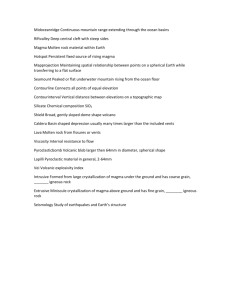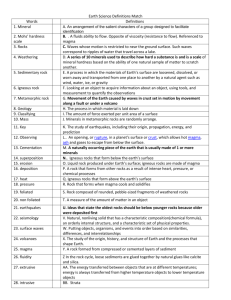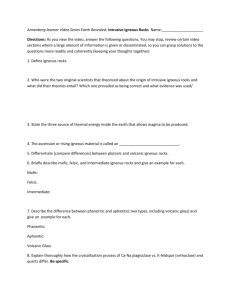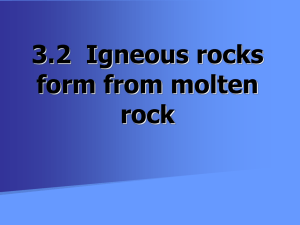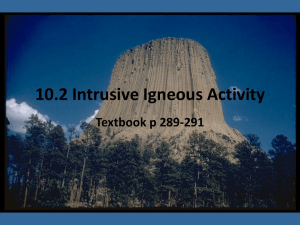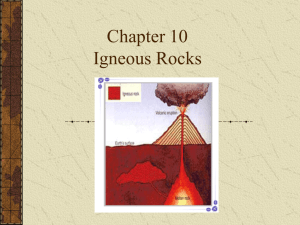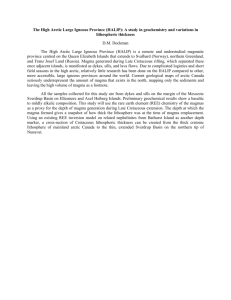Video_Exercise_Earth_Revealed_Igneous_Rocks_KEY
advertisement
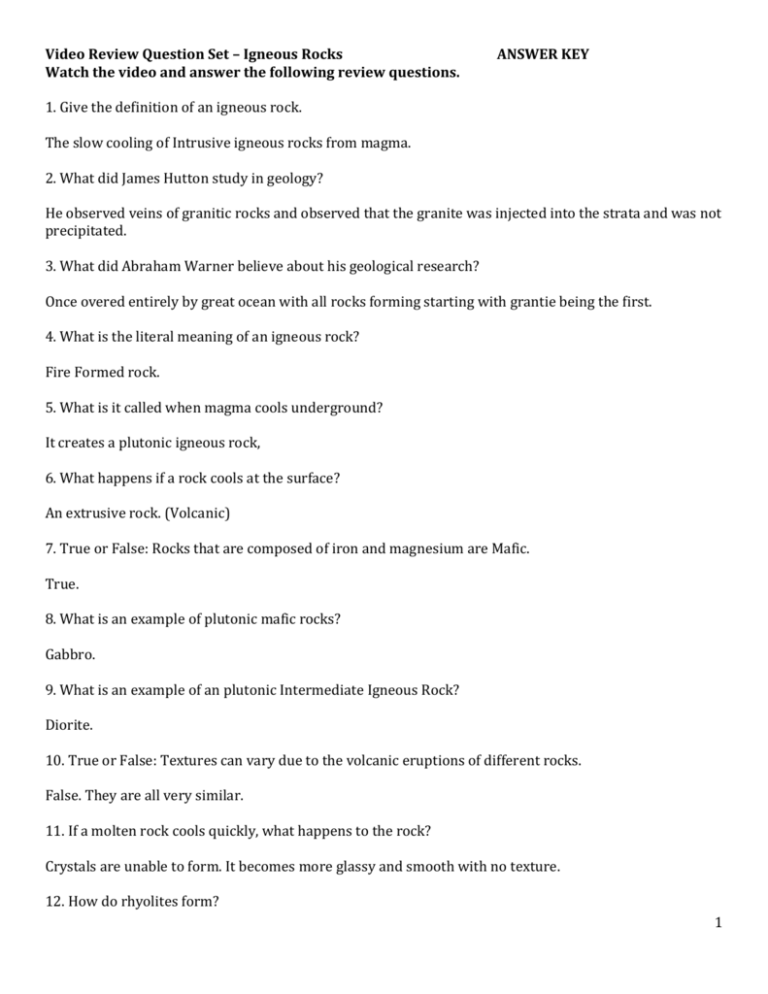
Video Review Question Set – Igneous Rocks Watch the video and answer the following review questions. ANSWER KEY 1. Give the definition of an igneous rock. The slow cooling of Intrusive igneous rocks from magma. 2. What did James Hutton study in geology? He observed veins of granitic rocks and observed that the granite was injected into the strata and was not precipitated. 3. What did Abraham Warner believe about his geological research? Once overed entirely by great ocean with all rocks forming starting with grantie being the first. 4. What is the literal meaning of an igneous rock? Fire Formed rock. 5. What is it called when magma cools underground? It creates a plutonic igneous rock, 6. What happens if a rock cools at the surface? An extrusive rock. (Volcanic) 7. True or False: Rocks that are composed of iron and magnesium are Mafic. True. 8. What is an example of plutonic mafic rocks? Gabbro. 9. What is an example of an plutonic Intermediate Igneous Rock? Diorite. 10. True or False: Textures can vary due to the volcanic eruptions of different rocks. False. They are all very similar. 11. If a molten rock cools quickly, what happens to the rock? Crystals are unable to form. It becomes more glassy and smooth with no texture. 12. How do rhyolites form? 1 They crystalize from magma cooling slowly at first, with allowance of other different minerals. 13. What is a phanoritic crystal? It is an easily visible coarse-grained texture and crystalize very several kilometers deep. 14. True or False: Magma can only crystalize one igneous rock at a time. False. Magma can crystalize one or two mineral types at a time. 15. What information does Norman Bowen give us information about how magma crystalizes? Bowen called it a reaction series. Magma cool easily mineral may react to form new minerals at lower temps. 16. At what temperature does calcium plagioclase crystalize? 1,100 Celsius. 17. What is an example of at highest temperature mineral in Bowen’s reaction series? What about the lowest? Olivine. Biotite. 18. True or False: The lower temperature mineral in the continous series of Bowen’s reaction is calcium plagioclase. False. It is sodium plagioclase 19. What four examples are leaning towards Felsic mineral constituents? Feldspar, biotitic, muscovite and quartz. 20. What is the origin of granite? Magma starts as basaltic material, through process of melting slowly and differentiation. 21. What is differentiation? Materials crystalizing at higher temperatures becoming separated from the magma. 22. What is the difference between magma on continents than magma on seafloor? Seafloor is enriched in iron and magnesium being high temperature, being basaltic mostly. Subduction zones are cooler wet rocks and sub ducted under; melting begins lower temperature, plus are higher silica rocks. 23. What is the plutonic equivalent of the volcanic rock Andesite? 2 Diorite. 24. What do geologists believe how magma forms containing these minerals mentioned above? They believe magma develops with melting of basalt, from upper part of lithosphere; also components could and may be derived from sediments carried down. They may be dissolved in magma with serpentine with the basalt and possibly contribute water helping with overall the formation of magma. 25. What creates partial melting in the mantle? Upwelling with subduction. 26. What are plutons and what do they do? They are large masses of igneous rock form on continental crust. They cool and form granite. 27. List the three ways that plutons react due to ascending plates? 1. Divergent plate boundaries, magma fills up spaces w/ crust pulling apart. 2. Convergent plate boundaries magma passes through while plutons are pushed aside. 3. Lastly, the magma may fracture the overlying rock through process called stope-ing. 28. What are xenoliths? Bits of fractured rock preserved with cooling in form of fragments. 29. What are dykes? Sheet like shapes cutting across fabric of preexisting rocks. 30. Sills? Sills intrude between layers, sheet, parallel to strata. 31. Laccolith? Shallow silica like structure building upwards making a gentle rise in crust. 32. How large can plutons be? They can range anywhere to 10 square kilometers to 100’s square kilometers. 33. What is another word for plutons? Batholiths. 34. What are plutonic rocks composed of? 3 Tightly interwoven mass of crystals. 35. What is an example of two types of ancient igneous rocks? Calamites and Orthosites. 36. What planet have researchers found that orthosites are near? The moon. 4


